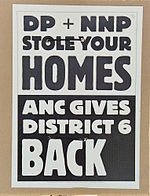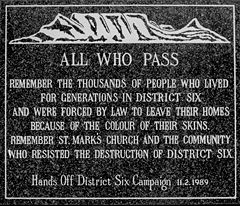- District Six
-
"District Six" redirects here. For other uses, see District Six (disambiguation).
District Six — Neighborhood — Country  South Africa
South AfricaProvince Western Cape Municipality City of Cape Town Wards Time zone SAST (UTC+2) Postal code District Six (Afrikaans Distrik Ses) is the name of a former inner-city residential area in Cape Town, South Africa. It is best known for the forced removal of over 60,000 of its inhabitants during the 1970s by the apartheid regime.
Contents
Creation and destruction
The area was named in 1867 as the Sixth Municipal District of Cape Town. The District Six neighbourhood is bounded by Sir Lowry Road on the north, Tennant Road to the west, De Waal Drive on the south and Cambridge Street to the east. By the turn of the century it was already a lively community made up of former slaves, artisans, merchants and other immigrants, as well as many Malay people brought to South Africa by the Dutch East India Company during its administration of the Cape Colony. It was home to almost a tenth of the city of Cape Town's population.
After World War II, during the earlier part of the apartheid era, District Six was relatively cosmopolitan. Situated within sight of the docks, it was made up largely of coloured residents which included a substantial number of coloured Muslims, called Cape Malays. There were also a number of black Xhosa residents and a smaller numbers of Afrikaans, whites, and Indians.
Government officials gave four primary reasons for the removals. In accordance with apartheid philosophy, it stated that interracial interaction bred conflict, necessitating the separation of the races. They deemed District Six a slum, fit only for clearance, not rehabilitation. They also portrayed the area as crime-ridden and dangerous; they claimed that the district was a vice den, full of immoral activities like gambling, drinking, and prostitution. Though these were the official reasons, most residents believed that the government sought the land because of its proximity to the city center, Table Mountain, and the harbor.
 ANC election poster linking rival parties to the history of forced removals.
ANC election poster linking rival parties to the history of forced removals.
On 11 February 1966, the government declared District Six a whites-only area under the Group Areas Act, with removals starting in 1968. By 1982, more than 60,000 people had been relocated to the sandy, bleak Cape Flats township complex some 25 kilometers away. The old houses were bulldozed. The only buildings left standing were places of worship. International and local pressure made redevelopment difficult for the government, however. The Cape Technikon (now Cape Peninsula University of Technology) was built on a portion of District Six which the government renamed Zonnebloem. Apart from this and some police housing units, the area was left undeveloped.
Since the fall of apartheid in 1994, the South African government has recognized the older claims of former residents to the area, and pledged to support rebuilding.
Area
The District 6 area is situated in the city bowl of Cape Town. It is made up of Walmer Estate, Zonnebloem, and Lower Vrede (the former Roeland Street Scheme)[1]. Some parts of Walmer Estate like Rochester Street were destroyed and some parts like Cauvin Road were left but the houses demolished. In other parts of Walmer Estate like Worcester Road and Chester Road people were evicted but only a few of the houses destroyed. Most of Zonnebloem was destroyed except for a few schools, churches and mosques. A few houses in the old Constitution street (now Justice Road) were left but the homes sold to white people. This is the case with Bloemhof flats (renamed Skyways). Most of Zonnebloem is owned by the Cape Technikon (which also is built over 50% of the land).
Return
By 2003, work had started on the first new buildings: 24 houses that will belong to residents over 80 years old. On 11 February 2004, exactly 38 years after the area was rezoned by the government, former president Nelson Mandela handed the keys to the first returning residents, Ebrahim Murat (87) and Dan Ndzabela (82). About 1,600 families were scheduled to return over the next three years[2].
The Hands Off District Six Committee mobilized to halt investment and redevelopment in District Six after the forced removals. It developed into the District Six Beneficiary Trust, which was empowered to manage the process by which claimants were to get their "land" back (actually a flat or apartment residential space). In November 2006, the Trust broke off negotiations with the Cape Town Municipality. The Trust accused the Municipality (then under a Democratic Alliance mayor) of stalling restitution, and indicated that it preferred to work with the national government, which was controlled by the ANC. In response, DA Mayor Helen Zille questioned the right of the Trust to represent the claimants, as it had never been "elected" by claimants. Some discontented claimants wanted to create an alternative negotiating body to the Trust. However, the historical legacy and "struggle credentials" of most of the Trust leadership made it very likely that it would continue to represent the claimants.
Museum
In 1989 the District Six Museum Foundation was established, and in 1994 the District Six Museum came into being. It serves as a remembrance to the events of the apartheid era as well as the culture and history of the area before the removals. The ground floor is covered by a large street map of District Six, with handwritten notes from former residents indicating where their homes had been; other features of the museum include street signs from the old district, displays of the histories and lives of District Six families, and historical explanations of the life of the District and its destruction. In addition to its function as a museum it also serves as a memorial to a decimated community, and a meeting place and community center for Cape Town residents who identify with its history.[3]
Arts
With his short novel A Walk in the Night (1962), the well-known Capetonian journalist and writer Alex La Guma gave District Six a place in literature.
South African painters, such as Kenneth Baker, Gregoire Boonzaier and John Dronsfield are recognised for capturing something of the spirit of District Six on canvas. [4]
In 1973, Adam Small and Chris Jansen combined to make coffee table book with Jansen's photographs of District 6 and the demolition of it, with moving poems by well-known poet and writer, Adam Small. The book was published by Human and Rousseau.
In 1986, Richard Rive wrote a highly-acclaimed novel called Buckingham Palace, District Six, which chronicles the lives of a community before and during the removals. This book has also been adapted into successful theatre productions which toured South Africa.
In 1986, District Six – The Musical by David Kramer and Taliep Petersen told the story of District Six in a popular musical which also toured internationally.[5] In 1997 Pamela Jooste wrote her wellknown book,"Dance with a poor Man's daughter". It is the story of District 6 as experienced by an intelligent little girl who lived there. District Six also contributed mightily to the distinguished history of South African jazz. Basil Coetzee, known for his song "District Six", was born there and lived there until its destruction. Before leaving South Africa in the 1960s, pianist Abdullah Ibrahim lived nearby and was a frequent visitor to the area, as were many other cape jazz musicians. Ibrahim described the area to The Guardian as a "fantastic city within a city...", explaining, "[W]here you felt the fist of apartheid it was the valve to release some of that pressure. In the late 50s and 60s, when the regime clamped down, it was still a place where people could mix freely. It attracted musicians, writers, politicians at the forefront of the struggle. We played and everybody would be there." [6]
South African writer Rozena Maart, currently resident in Canada, won the Canadian Journey Prize for her short story "No Rosa, No District Six". That story was later published in her debut collection Rosa's District Six.
South African singer/songwriter Warwick Lobban wrote about District Six in his song "The Town".
Tatamkhulu Afrika wrote the poem "Nothing's Changed", about the evacuation of District Six, and the return after the apartheid.
District Six was also the album title of industrial group Amphibious Assault. The lyrics "You can take the people out of the heart of District Six but you'll never take District 6 out of the heart of the people" were used in the album on the title track.
District 9 is a 2009 science fiction film produced by Peter Jackson and directed by Neill Blomkamp. Although set in an alternate Johannesburg, it is inspired by the events surrounding District Six.[7]
Notes
- ^ http://www.up.ac.za/dspace/bitstream/2263/10162/1/Coetzer_Exploring(2008).pdf-
- ^ "Making amends for apartheid: the resurrection of District Six". The Independent. 15 March 2004. http://www.independent.co.uk/news/world/africa/making-amends-for-apartheid-the-resurrection-of-district-six-566365.html. Retrieved 27 October 2009.
- ^ "District Six Museum". International Coalition of Historic Sites of Conscience. http://www.sitesofconscience.org/index.php/sites/district-six/en/. Retrieved 2006-12-17.
- ^ Jeppie, Shamil; Soudien, Crain (1990). The Struggle for District Six: past and present. Buchu Books. p. 112. ISBN 0958305730.
- ^ "District Six - The Musical". Musicmakers. http://www.musicals.co.za/district_six.html. Retrieved 2006-12-17.
- ^ Jaggi, Maya (8 December 2001). "The sound of freedom". The Guardian. http://www.guardian.co.uk/saturday_review/story/0,3605,614946,00.html. Retrieved 18 August 2009.
- ^ "Alien Nation". Newsweek. http://www.newsweek.com/2009/08/26/alien-nation.html. Retrieved 4 August 2010.
References
- Western, John. Outcast Cape Town. Berkeley: University of California Press, 1996.
- Bezzoli,Marco; Kruger, Martin and Marks, Rafael. "Texture and Memory The Urbanism of District Six" Cape Town: Cape Technikon, 2002
External links
- The District Six museum
- The District Six Beneficiary and Redevelopment Trust
- Southern Cross (SA Catholic newsweekly) article on District Six
- Interview with museum director on history of District Six, purpose of museum
- Community Video Education Trust: a digital archive of 90 hours of videos taken in South Africa in the late 1980s and early 1990s including women of Lavender Hill talking about removals from District Six (June 6, 1985) and Albie Sachs at District 6 on his return from exile (1991). Other raw footage documents anti-apartheid demonstrations, speeches, mass funerals, celebrations, and interviews with activists that capture the activism of trade unions, students and political organizations mostly in Cape Town.
- Interview with District Six Museum founder about his life in District Six and his motivation to start the museum.
- District Six at Golden Arrow
Categories:- Suburbs of Cape Town
- Places associated with apartheid
Wikimedia Foundation. 2010.


